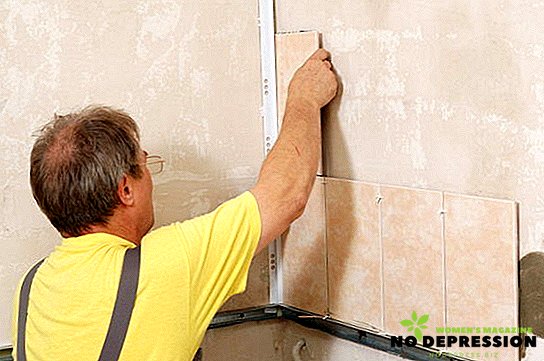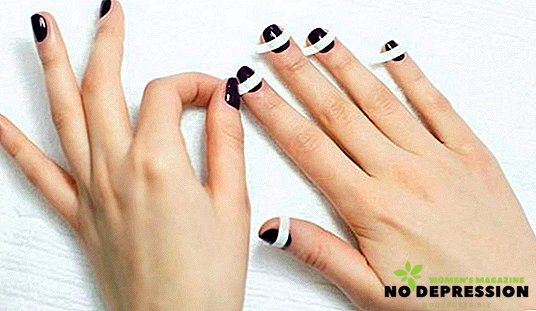None of the repair work can be done without laying tiles: for facing the walls in the bathroom and toilet, kitchen, on the balcony, etc. Such work is quite expensive, because many are trying to lay tiles on the wall with their own hands. This is not as difficult as it seems at first glance, if you follow the instructions clearly.

Types of tiles and its features
The first thing to do is to choose a tile, because the final result depends on its quality. First of all, you need to choose the type of tile that happens:
- tiled;
- ceramic.
There are practically no differences between them, but tiled due to the applied coating looks more stylish, but at the same time it is more difficult to work with it, because the coating in the form of glaze is very fragile and with the slightest error during cutting and styling can crack. Ceramic tiles are more durable, because it is more often used for finishing toilets and bathrooms.
In addition to the attractiveness you need to pay attention to the geometry of every detail. Even with millimeter irregularities of the ends or small defects on the surface, the risk of splitting of the material during installation increases.
The laying process itself requires caution and attention, especially for undercuts. Fragile materials need to be cut very carefully, and it is not allowed to level or trim the same tile twice, because after such treatment the products will start to crack.
The evenness of the surface is also important - millimeter troughs or bumps are invisible when working, however, after installation, they can spoil the appearance of the surface.
Another important point is to check the angles, the value of which should fully comply with 90 degrees, otherwise you can get a divergence of seams that cannot be straightened with the help of crosses.
The calibration is also important: the length and width of the tiles in the same batch must be 100% identical, otherwise there will again be discrepancies at the seams.
And the thickness of the material should be checked even in the store, examining each tile in the package. Despite the existing standard, which states that 2 mm thick discrepancies are allowed, it will be very difficult to work with such materials.
What mixture to use for fastening
Modern manufacturers offer a variety of adhesive compositions, which are different and included in the ingredients, and quality:
- For interior work. It is considered the cheapest option that can be used only for interior decoration. Despite the low content of additives, which are aimed at improving the properties of the adhesive, such compositions do a good job of their duty. However, it is best to use for living rooms where there are no sharp temperature fluctuations - in this case, the adhesive base will last for a long time.
- A mixture of increased fixation. Withstands heavy loads. It is for this reason that the tool is used in the decoration of rooms that are subject to temperature fluctuations, dynamic effects. Often such compositions are used in the installation of large-format tiles, including those made from natural stone. The main advantage of this composition can be called the fact that this tile can hold on to the old lining.
- Universal adhesive mixture, which is the most common among professionals. It can be used for both internal and external works. True, it is not recommended to apply to work with tiles larger than 30 * 30 cm or in rooms with high humidity levels.
- Water repellent formulations. They are used in the decoration of pools, fountains, bathrooms. The composition is similar to the glue of strong fixation with additives that give the mixture hydrophobic properties.

Laying tiles on the wall: a walkthrough
For the result to please you for a long time, it is very important to carry out all the activities correctly. Therefore, it is worth paying attention to every step.
Training
It is the most important stage. The quality of the prepared surface depends on the final result. The preparation process is quite long:
- They start work by removing the old coating - nothing should remain on the surface, which is especially important when finishing the walls after wallpaper. After applying the glue, even a small piece of paper will absorb moisture and after some time will begin to peel off, “pull” the solution behind it, which can result in delamination of the tile.
- It is required to plaster the surface in the presence of "blockages", since the walls must be perfectly smooth.
- Surfaces are coated with a primer, and it is better to choose a deep penetration primer with antiseptics. This will not only strengthen the walls, but also protects against fungi, moisture, and mildew.
If you are laying tile on a surface covered with paint, you need to make a few notches on it to ensure a good grip.

Markup
A very important stage - markup. Before this, it is imperative to decide on the pattern on the walls you want to achieve. There are two options:
- using scraps;
- with minimal consumption of tile material.
In the first case, the whole tile is first laid, and at the end of the empty space - trimming. In the second case, first measure the area of the entire surface, then cut the tile so that there are no undercuts. Moreover, all lines must be marked with the use of building level for evenness.
When marking it is important to remember that the rules for laying tiles require determining the height of the first row, from where the work will begin. For example, when installing products in the kitchen in the form of an apron over the working area, you first need to mark the lower border of the tile, then draw a line from it to determine the orientation of the installation of the metal profile - it will be the support for the tiles.

Laying tiles in a bathroom or toilet starts with markings from the floor, and the number of rows determines the number of rows according to the seam width and the tile itself. When marking also need to take into account the size of the crosses, which are necessary for keeping the same width between rows.
Installation
After preparation of the adhesive composition and layout, you can proceed to installation.
They start work from the bottom row and the middle of the wall - it should be the central seam, because it always catches the eye first and attracts attention. Trims (if any) should be left to be placed in remote corners. Glue is applied to the surface of the walls with a wide trowel - 3-4 tiles per installation area. Using a comb trowel, remove excess material.
The glue is also applied to the tile: by the middle, the thickness of the composition should be about 3 mm, to the edges - about 0.5 mm. Tile gently applied to the wall, based on the markup. The material should be tapped with a rubber hammer, leveling strictly to the level. So lay out the entire series, not forgetting the installation of tiled crosses.
Similarly, the assembly of all rows is carried out, leaving free space from the tile to the inner corner, since this part needs to be closed last.

Completion of work - installation trim. They should be left for last, since such work is very laborious. Mounted pieces of tile in strict accordance with the pattern, at the same time checking the flatness of laying with the help of construction level.
It will remain to grout the joints, for which you need to use dry mixes - they are diluted with water in the proportions indicated in the instructions, bringing thick sour cream to the consistency. Grout put in the seams with a soft rubber spatula. Wipe the tiles with a soft, dry cloth to remove any grouting residue.
To lay the tile yourself, you should follow a number of rules: choose the material correctly, carefully carry out the preparatory work and carry out the installation according to the above recommendations.
If you are not sure that you can cope with this kind of work, you can contact the experts: the cost of laying (with surface preparation) of one square meter is about 600 rubles.












